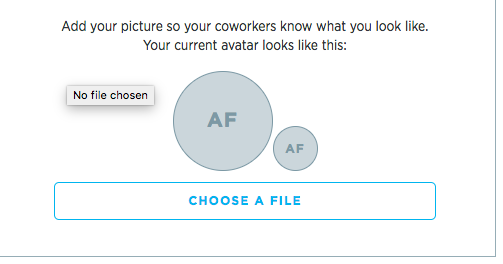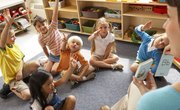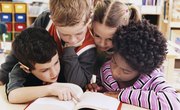For people who have been reading and writing for years, it's unthinkable to imagine a time when they could not recognize letters or words. However, as children learn to read they must begin to connect the symbols they see on the page with the letters they have heard and spoken.
One of the key aspects of teaching reading is teaching word recognition, both by sight and sound. There are a number of strategies that teachers can employ to get students to recognize words.
What Is Word Recognition in Reading?
When a reader with years of experience reads a page, he doesn't stop and read every word and wonder what it means. What experienced readers do that allows them to read quickly and efficiently is called word recognition.
The more fluent a reader is in word recognition, the easier it will be for him or her to comprehend complex text and challenging abstract concepts. On the contrary, slow word recognition means constant reading and analysis of words and sentences. When readers struggle with word recognition, their memory and their comprehension skills are quickly drained from spending so much time on analysis.
Learning Word Recognition
The best way to gain word recognition is repeated and consistent exposure to the same words over and over. This is simple for avid readers, but it is something critical for children who are just beginning to read or who are given the opportunity to look at books regularly.
Despite the fact that the English language is vast and rich and contains a tremendous vocabulary, the fact is that only around 100 words comprise about 50 percent of the words that all people read in English each day.
This means that constant exposure to the words that most people need to read to navigate their lives is not difficult to orchestrate. These words are around and available. When a child begins to remember that the letters "a-n-d" spell the word "and," she will immediately recognize it and move on to the next word. There is no more sounding out, no more analysis. Their word recognition propels them forward as they read.
How to Teach Contextual Word Recognition Activities
Understanding word recognition is simple. Being able to teach word recognition is hard. This is a particular challenge for teachers who have a classroom where students are at varying levels of experience and competence with the material. The most consistent and successful way for children to learn word recognition is to expose them over and over to text that contains these words, particularly text that is not especially challenging to comprehend.
The more children are exposed to books with the same words in them, the sooner they will recognize the shape and size of a word rather than needing to read it.
Use More Clues
Context clues are when readers rely on the ancillary content of a sentence or a page to guess at what word might be suggested. In this way, the context can help the reader to anticipate the word. Another great way to help students recognize words is to provide syntactic clues or word order clues.
Often the structure of a sentence will help a student to guess whether the word that is next is a verb, a noun or an adjective. Outside the realm of words, pictures or illustrations can help to bridge a connection between the picture of the word and the spelling of the word. This association may be especially helpful for students who are highly visual. Contextual word recognition activities are among the most valuable.
What Are Some Good Word Recognition Strategies?
Science has shown that the human brain is hardwired for speech, but the same is not said of reading or writing. The facts of this are that the language, English, is an invention, as are all languages. This means that the brain must extend itself and create a new neural pathway that helps to translate the marks you are seeing on the paper and connect them to the sounds you use when you speak. This is a tremendous feat for the human brain.
When you look at things from this perspective, it makes sense that learning to read can be hard for some people. This is in part because when you write words, you break them down into smaller blocks called phonemes. These blocks are essentially the 'atoms" of words. Unlike languages like Chinese, where a character can stand for a whole word or an entire syllable, the English language has an alphabet where words are broken down to individual sounds, and the sounds are rearranged.
This means that in order to read and write in the language, young readers must be able to identify and separate the different sounds in the words and recognize them as the symbols they see written out on the page. This means that teaching word recognition strategy will likely involve not only extensive reading on the part of the child but extensive speaking and mirroring the speech by associating it with the written word.
What Are Some Word Recognition Activities for Young Readers?
Begin by helping students sound out the words they are seeing. Whether or not they get the word quickly is not the issue. Having them work through each sound while looking at the word that is made up of those sounds creates a connection.
Once they have sounded out what the letters in "pat" do, they will be able to read that word. They will, with repetition, be able to understand when they see that word again that those sounds are made by those shapes.
Help the student identify the word "chunks." This is especially useful with older readers who are working on understanding compound words. By sounding out the chunks and then putting them together, the student will start to be able to recognize and identify specific word "families." This word recognition activity for middle schoolers will help them to identify words that they already know, and then put those words in context and see if they are able to make sense of the sentence.
Asking a student what a particular word looks like or reminds them of can often be a good jumping off point for identifying the word they are faced with. If there's a letter in it that reminds them of another word, start there. See if making that letter sound and indicating which part of the word it shows up it helps to create a moment of recognition for the student.
What Are Word Recognition Strategies for Diverse Learning Levels?
As difficult as it is for the average student to learn how to read words with instant, automatic recognition, it is even more challenging for students with special needs. Kids with special needs who struggle to learn word recognition might see letters in reverse position and may mix up the sounds of letters that look similar, such as "d" and "b" or may struggle to place sound chunks together.
This is why it is important for teachers to have word recognition activities for preschoolers at the ready just in case there is a need to work on basic skills with students.
Phonological Awareness
Phonological awareness is one of the most critical aspects of true word recognition. Phonological awareness means being able to identify and be aware of sounds as they are found in different words and applying that phonetic knowledge when you encounter an unfamiliar word. Word recognition games around phonemes are popular and can be done as a parent or a teacher.
One example is asking children to identify the sounds at the beginning of several words that start with the same letter. Then ask the children to identify the sounds at the end of several words that end in the same letter. This will strengthen their understanding of these letters and their spoken counterparts. This will help them to recognize the letters as functioning entities next time that they encounter them.
What Is the Difference Between Word Recognition and Word Identification?
Word recognition describes the cognitive act of remembering or recognizing a familiar word that has been seen before. Word identification, on the other hand, is the process of decoding the meaning of the word through its phonetic sounds. In other words, sounding a word out. These are two methods by which students internalize new vocabulary words.
Even the most seasoned reader occasionally encounters a word that he or she has never seen before. In the case of an exceptionally long or oddly spelled word, the reader does not resort to word recognition. They have simply never seen this word before. The process that then takes over is called word identification. This means that the reader will slowly sound out the word, recognizing the phonemes he or she has seen before, and thus be able to read the word.
Reading comprehension is, of course, the ultimate goal. Both word recognition and word identifications are strategies and skills that when honed, can help increase overall comprehension. The more words a reader is able to instantly recognize and process, the faster he or she will be able to comprehend what is being read. This means that the occasions where a word needs to be sounded out, identified, processed and understood is far rarer. The result is that comprehension isn't slowed down by constant reflection and analysis.
How Is Word Recognition Related to Fluency?
Word recognition activities are not designed simply to increase the vocabulary of the student. If this is a byproduct of word recognition that is wonderful, and it is part of the reason why avid readers have such large vocabularies. However, the goal of word recognition is the improvement of reading comprehension. Whether someone is reading the directions on a dangerous household chemical, or reading a bedtime story, the ability to immediately recognize and subconsciously process every word helps.
Fluency is achieved when a reader has sufficient word recognition to be able to comprehend everything he or she is reading. This means that the reader isn't slowing down every third word to figure out what the word is, and thus forgetting what came before. This type of difficulty can lead to reading sentences over and over and over again with no clear comprehension. Increased recognition leads to increased speed and facility with language. This, in turn, leads to increased comprehension and ultimately, fluency.
Related Articles
References
Writer Bio
Ashley Friedman is a freelance writer with experience writing about education for a variety of organizations and educational institutions as well as online media sites. She has written for Pearson Education, The University of Miami, The New York City Teaching Fellows, New Visions for Public Schools, and a number of independent secondary schools. She lives in Los Angeles.











